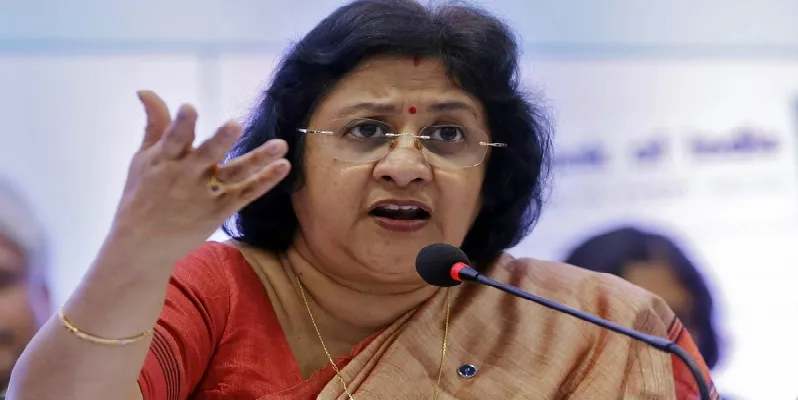'I don’t believe that India can be a cashless economy,' says SBI Chief Arundhati Bhattacharya at WIEF 2017
Post demonetisation, like any player in the digital payments space or with a digital payments arm, the government-owned banking corporation, State Bank of India, also witnessed a boom in the adoption of its tech-enabled services. Their wallet is now downloaded 70,000 to 80,000 times daily, as opposed to the feeble rate of 6,000-7,000 a day before demonetisation. The transactions at their POS touchpoints would normally amount to Rs 95 crore a day, but now approach the Rs 450 crores mark.
In spite of these promising numbers, Arundhati Bhattacharya chose to go with a cautiously optimistic stance, rather than spout the excited hyperboles doing the rounds – like demonetisation being a “surgical strike” on cash, and that India is now going to go completely cashless in a short period of time – at the Wharton India Economic Forum 2017 that was held in Mumbai.

The paradoxes in our cashless goals
“Whether demonetisation came prematurely, only history will tell. While it has indeed given a huge push to the digital economy, I don’t really believe that India can be a cashless society. I always say that we will be a “less-cash” economy - that is a more reasonable goal to work towards,” she states, at what was the tenth edition of Wharton’s annual event.
Explaining the paradox of the transaction cost conferred upon users who opt for the digital methods of payment that are being heavily promoted by our government, Arundhati explains how, ideally, in a cashless transaction that requires less human intervention, the cost advantage must be transferred to the consumer. However, we are at a stage where we haven’t been able to completely jettison the manual and usher in the digital. Hence, the cost advantage of the latter is cancelled out by the cost disadvantage of the former, thus giving rise to a great hindrance in the path to a complete digital economy and cashlessness.
“Transactions will become less costly, but only over a period of time. But it is valid that until that happens, people will question why they should switch to digital if it costs them money, and that will elongate the transition,” she explains.
Moreover, in a country where 75 percent of the total population is under 25, which is the generation most accepting of newer technologies (rural youth being no exception), according to Arundhati, there is still a sizable population that believes in the human touch, and in standing in queues to see their transactions physically fold out.
The Andhra Story
What’s more, accessibility to services remains as big a gap as the provision of them. Closing the gap will require more efforts, she says, adding that the necessary condition for a secure digital future is the uniform division of technology across all demographic groups and in all forms of production processes, primary and secondary.
“In India, there are wide disparities. Focusing on increasing the internet’s bandwidth and speed under the pretext that it will boost GDP is not really enough when both its penetration is low and its distribution is unfair. We have just gone through demonetisation, and we have just seen that the very things that were meant to empower India could also be used for subverting a process,” she opines.
Considering the level of digital awareness in rural areas, if we try to push the digital economy too fast, too quickly, the abuses will then also become prevalent, according to Arundhati. She cites the example of fair-price shops in Andhra that had adopted Aadhar-enabled technology.
Citizens coming in to collect their rations will actually be registered with Aadhar, put their fingerprint, and thereafter have their rations made available to them. While the Andhra government said that they had cut down a lot on false ration cards and leakages in the system, someone from another bank who had visited these shops to determine what was going on reported that there are many people who still don’t understand the slips that are coming out of the POS machine. So, someone who is only purchasing, say, 5 kgs of rice is being billed for a litre of kerosene as well. The seller doesn’t take the money for the kerosene, but ultimately sells it on the black market. “So, ultimately, everything has become digital, leakages have gone down, but if basic literacy is not there, we cannot promote this and expect it to have the right results. So, apart from access, basic literacy and understanding are key in truly achieving the goals of digital India,” she states.
SBI's Switcheroo
Having said that, she acknowledges that there is one advantage that India has with regard to proceeding towards a digital economy - there is no dearth of talent or innovation. With more than 4,000 startups, India is the third largest startup nation in the world - just behind the US and the UK. “The innovations that we come up with are game-changers. In the past 60 days, the amount of innovation we have seen to popularise digital is humongous,” she says.
SBI’s new technology for 'arhatiyas' is itself a prime example. Normally, when one’s debit or credit card is swiped, the payment is collected from one’s account. But there was a problem faced by the arhatiyas, the agricultural aggregators that sit in mandis or vegetable markets and buy the produce of farmers. They needed to pay these sellers, who, unlike them, may not have possessed a POS machine, thus making payment collection tricky in the times of demonetisation. So, SBI started facilitating ‘reverse transactions’.
Starting with a pilot in Maharashtra, if the arhatiya has a POS and the farmer has a card, the farmer will swipe that card and receive payment. “Instead of merely debiting amounts, we are also crediting them now. These are innovations that have happened in the past few days. Imagine the advantages. The farmer gets the money directly in his account, he gets an SMS to keep track, and the arhatiya doesn’t have an excuse that he doesn’t have cash and cannot make the payment,” she explains.
Asking the right questions
Digitisation also significantly disconnects the place of business from the place of consumption. Consequently, it becomes increasingly difficult to fix the location of the value created by this economy and to apply the rules of tax so that these can be properly brought under the revenue net. “Unless this is ascertained, implemented and perfected, our country will face revenue loss, impacting its growth and position,” says Arundhati.
She is also concerned about the technological revolution minimising human intervention to the extent that it will, effectively, take away jobs from people.
“How do the virtual and physical economies interact? What are the positives and negatives that emerge from this interaction, and finally, how do we measure the contribution of this digital economy? Is GDP, as a measure, suited to measure this new economic phenomenon?” she concludes by asking.







